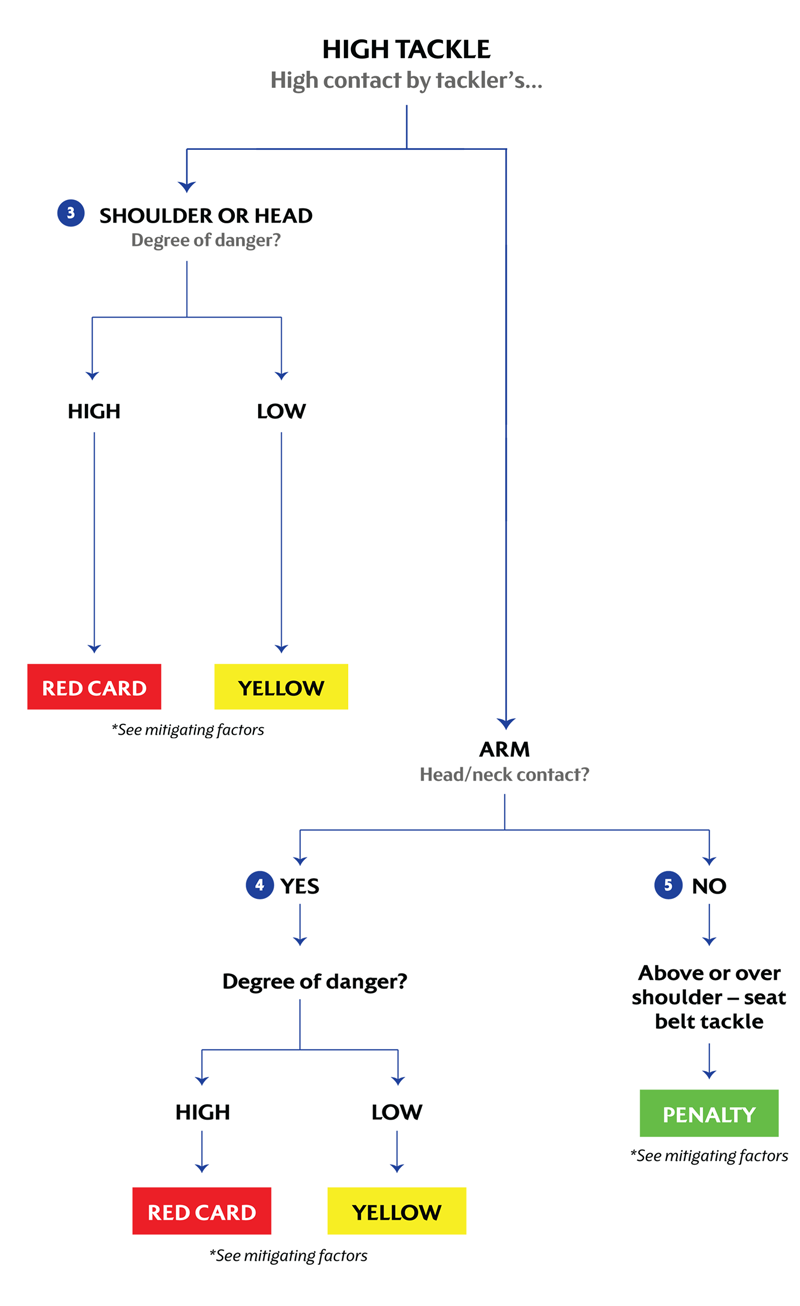Decision-making framework for high tackles - May 2019
This guideline has been superseded by the Head Contact Process announced in March 2021 and updated March 2023.
--------------------------------------------------------------------------------------------
Download this guideline as a PDF
Implementation dates
- Immediate for World Rugby competitions and International matches
- ASAP for all other competitions
- If a competition has already started, commencement can be at the start of the next competition window.
What is a framework?
A framework is a systematic tool that guides decision making
- Logical, step by step approach to the problem
What is a the goal of a framework?
Guide users to arrive at decisions that are:
- Consistent Accurate Objective (can be explained even with allowable disagreements)
What is the purpose of this framework?
Under Law 9.11, the referee is always entitled to issue a red or yellow card for anything that they deem to be reckless or dangerous.
However, the following guideline is intended to improve consistency in application of sanctions by distinguishing between dangerous tackles that warrant a penalty, yellow card or red card. The framework also supports protection of the head of both players by consistently and frequently sanctioning the tackle behaviour that is known to be the highest risk.
Three step process to use the framework
INITIAL DECISION
Is the tackle a shoulder charge or high tackle?
DEFINITIONS
Shoulder charge
Arm of the shoulder making contact with the ball carrier is behind the tackler’s body or tucked in ‘sling’ position at contact
High tackle
An illegal tackle causing head contact, where head contact is identified by clear contact to ball carrier’s head/neck OR the head visibly moves backwards from the contact point OR the ball carrier requires an HIA
Note: the head’s first movement is back in a head-contact tackle or head-contact shoulder charge, and forward in a ‘body-contact’ tackle or ‘body-contact’ shoulder charge
IF SHOULDER CHARGE OR HIGH TACKLE:
- Was there ball carrier head/neck contact? What is the degree of danger – high or low? Are there clear and obvious mitigating factors?*
* For mitigation, only one reduction in sanction can apply, irrespective of the number of mitigating factors present


VIDEO SIGNS INDICATING HIGHER DEGREE OF DANGER
Preparation
- Tackler draws the arm back prior to contact Tackler may leave the ground Arm swings forward prior to contact
Contact
- Tackler is attempting an active/dominant tackle, as opposed to passive/soak, or “pulling out” of contact Tackler speed and/or acceleration into tackle is high
- Rigid arm or elbow makes contact with BC head as part of a swinging motion
Follow through
- Tackler completes the tackle (as opposed to immediate release/withdrawal)
Factors to consider against mitigation:
- If the tackler and BC are in open space and/or the tackler has clear line of sight and time before contact
Mitigating factors
(must be clear and obvious and can only be applied to reduce a sanction by 1 level)
- Tackler makes a definite attempt to change height in an effort to avoid ball carrier’s head BC suddenly drops in height (e.g. From earlier tackle, trips/falls, dives to score) Tackler is unsighted prior to contact “Reactionary” tackle, immediate release
- Head contact is indirect (starts elsewhere on the body and then slips or moves up resulting in minor contact to the BC’s head or neck)
Summary of tackle circumstances warranting range of sanctions
RED CARD
- Shoulder charge (no arms tackle) to the head or neck of the ball carrier, and mitigation is not applied High tackle with any contact between the tackler’s shoulder or head and the BC’s head or neck, with high degree of danger, and mitigation is not applied High tackle with first contact from the tackler’s arm to the BC’s head or neck, with high degree of danger, and mitigation is not applied
YELLOW CARD
- Any red card offence where mitigation is applied (as per framework) Shoulder charge to the body (no head or neck contact), with high degree of danger High tackle with any contact between the tackler’s shoulder or head and the BC’s head or neck, with low degree of danger, and mitigation is not applied High tackle with contact from the tackler’s arm to the BC’s head or neck with low degree of danger, and mitigation is not applied High tackle with contact from the tackler’s arm, which starts elsewhere on the body and then slips or moves up resulting in minor contact to the BC’s head or neck, with high degree of danger, and mitigation is not applied
PENALTY
- Any yellow card offence where mitigation is applied (as per framework) Shoulder charge to the body (no head or neck contact), with low degree of danger High tackle with first contact from the tackler’s arm, which starts elsewhere on the body and then slips or moves up resulting in minor contact to the BC’s head or neck, with low degree of danger and no mitigating factors High tackle with first contact above or over the shoulder of the ball carrier, but without contact to the head or neck of the ball carrier during the execution of the tackle (seat belt tackle)